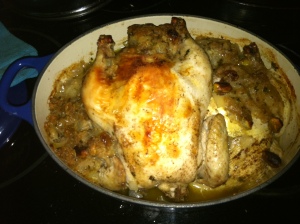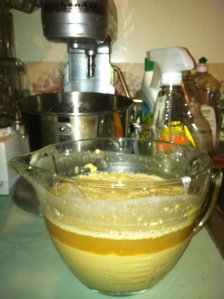Greetings! I can’t believe how long it’s been since I’ve posted. The last time I said anything of note here, I was researching dishes that could have been served during Richard II’s Christmas feast in Sicily. I did wind up making, since I’d already thawed out the game hens, my twist on how “beccafico” could have been prepared for the table.
Here’s what I did: I took four tiny game hens, sauteed up their tiny giblets with chopped onion, and mixed the minced up giblets and cooked onion with bread crumbs, pine nuts, raisins, and a little sugar. I moistened the mixture with lemon juice and vinegar, and filled the birds up with it. Then I layered the birds in my cast iron enameled baking dish, dotted the extra stuff in and around them, and named them, covered, for about an hour and a half at 325 degrees F.
Here they are:
They were incredibly tasty, but it got me to thinking about what kinds of dishes with small games hens or pigeons could have been around in Richard’s time.
Back in November, I finally got my own copy of Anna Martellotti’s “I ricettari di Federico II,” in which she compares the Liber de coquina, a 14th century cookbook attributed to the Angevin court of Naples; the Meridionale; the Anonimo Toscano; and a previously unpublished treatise from the Vatican Library; and draws the conclusion that the origin of many of the Liber de coquina recipes was not the Angevin court, but the Arab-influenced Norman-Swabian court of Frederick II. And the Vatican treatise was an earlier version of the Liber de coquina.
So I dove into Martellott’s book looking for cooking chickens together in a pot, and there’s a recipe from the Anonimo Toscano that has a vague similarity to what I did, as well as the ‘Ujja (Frittata) of Piegons from the Anonymous Andalusian, a 13th century cookbook from Spain. However, the Liber does not have anything specific about songbirds.
In December, I became the student of a a Laurel in the SCA – Danabren is the person I bounce research off of; she gives me pointers and hooks me up with resources. I also became a member of the Order of the Maunche, for my research about Norman Sicily. Danabren is a foodie but hampered in her enjoyment of much medieval cooking because of a diagnosed gluten intolerance; even most non-gluten grains are out (no barley, no rice, though she’ll indulge in sushi because the small amounts of rice involved are tolerable). She also had to cut out pretty much all of the sugar from her diet. Oh, and yeast is also right out.
Because she is an all-around cool person and I am a loyal student, and she was jonesing for a pizza-like substance, I started looking into what I could cook with bean flours, specifically chickpea. I was already familiar with pannelle from Palermo, and had come across the Genoese farinata and the socca from Nice.
So then I came across a reference to “gallettes of chickpeas,” based on the “cicera fracta” recipe from the Liber de coquina, and redacted the Liber recipe for my own use.
The original recipe for “Cicera fracta”:
|
Item, aliter : accipe cicera fracta et pone ad decoquendum cum
oleo, pipere et safrano et cum caseo detruncato et ouis perditis et ouis debatutis; uel aliter, cum ciceris fractis et perbullitis et, aqua bullitionis eiecta, ponatur cepa frissa et bene confecta cum lardo uel oleo sicut dies exigit. |
There seem to be two versions – either take mashed chickpeas, mix them up with oil, pepper, saffron, small pieces of cheese, and beaten eggs; or take mashed chickpeas and mix them with fried onions and bacon. The assumption is that each mixture is cooked, either as little cakes/pancakes, or in a dish like the way farinata is cooked. I decided to use chickpea flour because of the long traditions of chickpea flour dishes throughout the Mediterranean (and cicera fracta translates as “broken chickpeas,” and grinding them up is as broken as you can get).
You do have to let the chickpea batter stand for awhile before using it; most recipes say a minimum of three hours, but I like to let mine stand longer. What happens is this truly disgusting foam rises to the top:
I don’t know if that’s some sort of fermentation happening, but yuck is all I can say. You skim off the foam, though, and mix the separated liquids back together. Mix in some black pepper and salt, pump it into a greased baking dish, dot it with your chosen garnishes (a great combination is goat cheese, bacon, and fried onions), and bake it until it sets firm.
I plan to play with this recipe some more; for example, beating some eggs into the batter; using saffron; actually using mashed, cooked chickpeas instead of the flour; etc.

